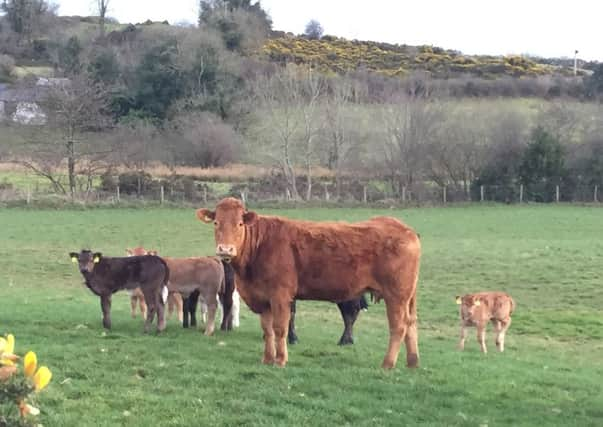Leptospirosis in cattle


Leptospirosis is a common infection in beef and dairy herds. In 2013 Leptospira hardjo was detected in 28 cases or 5.7% of foetuses submitted to AFBI in Northern Ireland.
Approximately 75% of UK cattle have been exposed to Leptospira hardjo, for which they are the “maintenance” host, which means that after infection they harbour the bacteria in their kidneys for months, even years, excreting many leptospires in their urine so acting as a reservoir of infection for other cattle.
Advertisement
Hide AdAdvertisement
Hide AdThe overall costs of disease caused by leptospires average out at £68-£106/ cow in an affected herd. In terms of cost per litre of milk, this works out at a loss of 0.91-1.41 ppl.
Economic losses result from:
Milk drop, also known as flabby bag. A sudden milkdrop occurs two to seven days after infection of susceptible cows. The udder becomes soft and flabby with colostrum-like secretions or blood-tinged milk in all four quarters. Signs may be mild and go undetected, but some cows become lethargic and stiff with a fever and reduced appetite. After five-six days the milk production will be resumed, but cows affected in late lactation may dry off altogether. If milk drop occurs before the peak of lactation then that peak will never be achieved. In a six-eight week period 30-50% of the herd may become infected.
In 2014 the Scottish Agricultural Colleges Consulting Services (SAC C VS) diagnosed leptospirosis in a 160 cow dairy herd where twelve cows experienced a sudden drop in milk production, with no other clinical signs observed. The affected animals had access to a stream shortly before the first case of milk drop was observed. SAC C VS considered that this natural watercourse may have been the source of infection.
Abortion: Abortion may occur three to twelve weeks following infection with most abortions occurring in the last three months of pregnancy. It can occur at any time of the year, but there is a marked seasonal incidence in late summer. Infection may also produce premature or weakly calves.
Advertisement
Hide AdAdvertisement
Hide AdInfertility: After infection, L. hardjo localises in the reproductive tract of the cow as well as in the kidneys, hence the suggestion that it may cause infertility in infected cattle.
Because L. hardjo localises in the kidneys, infection usually occurs when cattle come in contact with contaminated urine. Infected urine is the major vehicle, but direct transmission also occurs via the post-abortion discharge, via the infected placenta and by sexual contact through semen of infected bulls. The leptospires gain entry via the mucous membranes (eyes, nose, mouth, genital tract) and progress to three key organs: the udder, the uterus and the kidneys. Infection can also be transmitted transplacentally - foetuses may be infected at birth and harbour infection in the kidneys.
Leptospires can stay in the kidneys of infected cattle for a long period of time and these cattle will shed leptospires either intermittently or continuously for days or even years. These cattle provide a reservoir of infection and so have a pivotal role in maintaining infection within the herd.
Leptospires survive in warm wet conditions; the peak transmission time is from June to October. Leptospires can last up to four months in the environment.
Advertisement
Hide AdAdvertisement
Hide AdLepto boosters are generally given each spring. Cattle on concentrates are less likely to transmit leptospirosis - perhaps because of increased urine acidity than those at grass, so traditionally boosters are given before the period of peak transmission.
Disease is usually introduced in a herd by the purchase of infected cattle. L. hardjo has also been recovered from the urine of sheep; therefore cattle are more likely to become infected if sheep are present on the farm. As leptospira do not tolerate drying or exposure to sunlight, a rest period for two months after grazing by sheep or infected animals should make the pasture safe for uninfected animals.
Diagnosis can be made through laboratory testing of blood, milk or aborted material. After infection animals are likely to have detectable antibody in approximately three weeks. Bulk milk sampling is an effective way of monitoring level of infection within a dairy herd.
L. hardjo infection is a zoonosis; the infection is transmissible to man. Sources of infection for humans include urine, uterine discharges and abortion material. Dairy farmers are at increased risk to contract leptospirosis. Signs of infection include fever, headaches, muscle pain. Death is rare and results from liver and kidney failure.
Advertisement
Hide AdAdvertisement
Hide AdBiosecurity measures could help reduce the risk of exposure to infection; however it would be very difficult to completely eradicate bovine leptospirosis in the UK because of the high percentage of herds infected. In practical terms, vaccination will often be the best control option.
Spirovac® protects against Leptospira borgpetersenii serovar Hardjo for a duration 12 months. Vaccination reduces urinary shedding and this effect appears four weeks after vaccination.
Calves may be vaccinated from four weeks of age and should initially be vaccinated with two doses of vaccine separated by a four to six week interval. Boosters should be given on an annual basis.